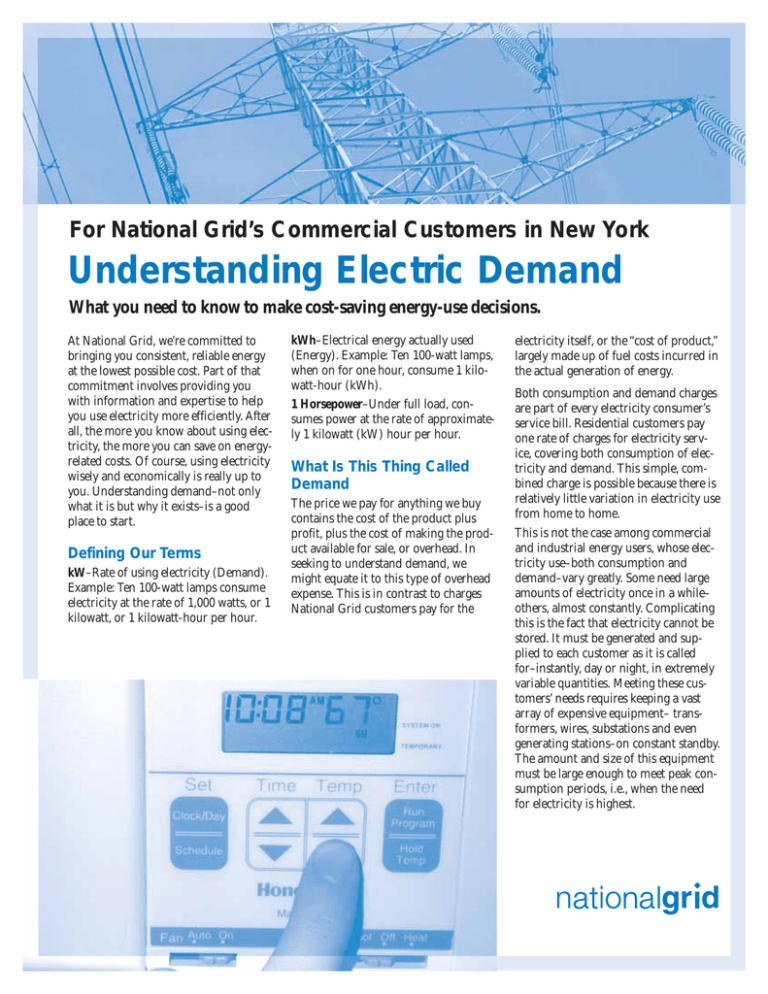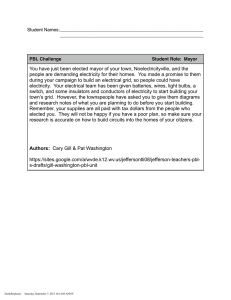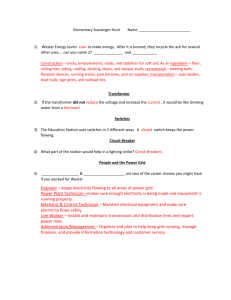Understanding Electric Demand
advertisement

For National Grid’s Commercial Customers in New York Understanding Electric Demand What you need to know to make cost-saving energy-use decisions. At National Grid, we’re committed to bringing you consistent, reliable energy at the lowest possible cost. Part of that commitment involves providing you with information and expertise to help you use electricity more efficiently. After all, the more you know about using electricity, the more you can save on energyrelated costs. Of course, using electricity wisely and economically is really up to you. Understanding demand–not only what it is but why it exists–is a good place to start. Defining Our Terms kW–Rate of using electricity (Demand). Example: Ten 100-watt lamps consume electricity at the rate of 1,000 watts, or 1 kilowatt, or 1 kilowatt-hour per hour. kWh–Electrical energy actually used (Energy). Example: Ten 100-watt lamps, when on for one hour, consume 1 kilowatt-hour (kWh). 1 Horsepower–Under full load, consumes power at the rate of approximately 1 kilowatt (kW) hour per hour. What Is This Thing Called Demand The price we pay for anything we buy contains the cost of the product plus profit, plus the cost of making the product available for sale, or overhead. In seeking to understand demand, we might equate it to this type of overhead expense. This is in contrast to charges National Grid customers pay for the electricity itself, or the “cost of product,” largely made up of fuel costs incurred in the actual generation of energy. Both consumption and demand charges are part of every electricity consumer’s service bill. Residential customers pay one rate of charges for electricity service, covering both consumption of electricity and demand. This simple, combined charge is possible because there is relatively little variation in electricity use from home to home. This is not the case among commercial and industrial energy users, whose electricity use–both consumption and demand–vary greatly. Some need large amounts of electricity once in a while– others, almost constantly. Complicating this is the fact that electricity cannot be stored. It must be generated and supplied to each customer as it is called for–instantly, day or night, in extremely variable quantities. Meeting these customers’ needs requires keeping a vast array of expensive equipment– transformers, wires, substations and even generating stations–on constant standby. The amount and size of this equipment must be large enough to meet peak consumption periods, i.e., when the need for electricity is highest. natio ionalgr d Utilities and public service commissions around the country have determined that the most equitable way to cover the cost of this equipment is to have those customers who create this demand and the need for power during these peaks pay for its availability. For this reason, utilities spread the costs of this extra equipment among all commercial and industrial customers as a separate charge for demand. Defining Demand Customers National Grid installs a demand meter whenever a customer’s energy consumption has exceeded 2,000 kilowatthours (kWh) per month for four consecutive months. Once demand billing begins, it does not end until after the monthly energy consumption has been less than 2,000 kWh for 12 consecutive months. This requirement may not be avoided by temporarily terminating service. New or existing customers whose connected load indicates that the energy consumption will exceed 2,000 kWh per month will have a demand meter installed. The demand charge will be the highest average kW measured in a 15-minute interval during the billing period, but not less than one kW and not less than the demand contracted for. Customers who do not create peaks but maintain a relatively level demand are known to have a high “load factor.” Utility pricing policies are designed to pass savings on to these customers. Comparing Demand and Consumption On every demand-billed customer’s energy service bill, charges for consumption and demand are separate. This exaggerated example illustrates how the two work: Suppose you have a commercial building with lighting, cooling, machinery, and miscellaneous electric equipment. Its fully installed load totals 15 kW. You are not using the building and have no employees. On the first day of each month, you come into the building and turn on all electrical equipment and leave it on for 15 minutes. Then you shut everything off again and lock up the building until the following month. What would your electric bill look like? It would show very little consumption; in fact, only 4 kWh, at a cost of about 28 cents. (Added to National Grid’s basic service charge of $47.25 per 30-day period, which includes maintenance of gas or electric lines, metering and other costs such as meter reading and billing, the total is $47.53.) But what about your demand charge? At an average cost of $8.32 per kW and the meter reading at 15 kW, the demand charge would be $124.80* (for customers in Service Classification No. 2, Small General Service-Demand). Service from March 3 to April 3 Basic service charge and electrical consumption 4 kWh $ 47.53 Electrical demand 15 kWh $ 124.80 AMOUNT NOW DUE $ 172.33 National Grid customers billed on the demand price who provide the transformers required to take service, as designated by National Grid, have their charges reduced by $ .90 per kW billed. Understanding Demand Metering Much like your car’s odometer records accumulated mileage, electric meters record consumption (kWh). Electric demand meters function like your speedometer–with an important difference. A demand meter’s needle advances as electricity consumption increases, just as your speedometer needle advances as your speed increases in a car. When you stop the car, the needle moves back to zero, regardless of the highest miles per hour reached on the trip. Unlike a speedometer needle, demand meters record the highest average kilowatts reached and maintained in a 15minute interval within the billing period. If your demand reaches 50 kW, for example, and stays there for 15 minutes, the meter needle remains at 50 kW unless or until your demand exceeds that level. If your demand later reaches 55 kW and stays there for 15 minutes, the needle will then stay at 55. The new index point is maintained, even when you are using electricity at below 55 kW, until the meter reader comes to record the demand and resets the meter back to zero. 10 kW 15 kW 15 10 5 0 20 25 30 = $208. Simultaneous Use For example, suppose you have a 10 kW motor in one part of the building and a 15 kW motor in another. If you operate both units simultaneously, the demand meter will record 25 kW. However, if you can use the motors alternately, operating the 10 kW unit only when the 15 kW unit is off, the maximum demand reading will be only 15 kW. The 10 kW saved would save about $83 per month, or $996 per year. 10 kW OR 15 kW 15 10 5 0 20 25 30 = $125. Alternate Use Some intermittently used equipment can be operated using various interlocks and automatic controlling devices. Since each kW demand saved is worth $8.32 per month (at early 2002 demand prices*), looking into these types of devices makes good sense. *For current National Grid electricity prices, see www.nationalgrid.com and click on Billing & Rates or call 1-800642-4272. Saving Energy with Demand Control There are many ways to manage demand, ranging from manual controls and timeclocks to sophisticated automatic units that program buildings and processes. For the average commercial building, the best control over electrical demand may not be in the electric system, but in the building itself. Good thermal design–tight construction, good window design, and appropriately sized ventilation systems–is the key to limiting demand and avoiding demand charges. It creates less need for heat and cooling, allowing you to select smaller, more cost effective equipment. Demand “Ratchet” Clause The demand “ratchet” clause applies only to National Grid customers on Large General Service Classifications receiving service under 15,000 volts whose monthly measured demand equals or exceeds 100 kW. At times, there will be a difference between these customers’ recorded demand as taken from the meter by our meter reader and the billing demand that the customer pays. For example, suppose a building with heating reaches a peak of 300 kW during one winter month. For the next 11 months, the minimum demand will be 150 kW per month for billing purposes, even though the recorded demand may have been less than 150 kW. This is because our pricing structure’s ratchet clause stipulates that the minimum billed demand will be not less than onehalf of the maximum demand recorded during the previous 11 months. When the ratchet clause is applied to your electric service account, both the meter-recorded demand and the billing demand are indicated on your bill. For Customer Information and Support With extensive training and wide-ranging, business-related backgrounds, our Commercial and Industrial Team members are knowledgeable about the concerns of business owners. They know that businesses need quick, expert answers. Whenever you have a need, question or concern, contact our Commercial and Industrial Team at 1-800-664-6729, Monday-Friday, 8 a.m.-5 p.m., or via email from www.nationalgrid.com (click on Contact Us). For information on other energyrelated topics, including current prices for electric service and supply, see www.nationalgrid.com or call 1-800642-4272. National Grid, through the transmission and distribution of electricity and natural gas, serves close to 4 million customers across 29,000 square miles of Massachusetts, New Hampshire, New York and Rhode Island. Its parent company, National Grid plc, is an international energy delivery business located in the U.K. with principal activities in the regulated electricity and natural gas industries. National Grid 300 Erie Boulevard West Syracuse, NY 13202 1-800-642-4272 www.nationalgrid.com NY0620 12/05 natio ionalgr d National Grid 300 Erie Boulevard West Syracuse, NY 13202 1-800-642-4272 www.nationalgrid.com




